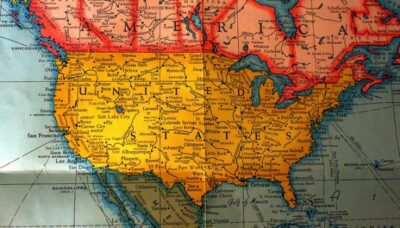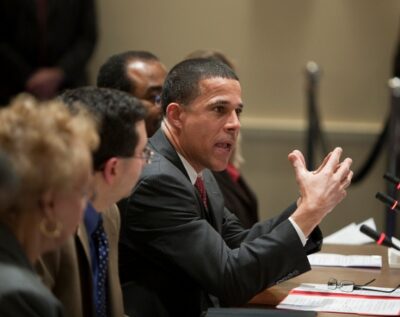Immigration at the Border

What the Show Me State Shows Us About Immigration
According to data released by the Immigration Policy Center, there are approximately 6,500 young people in Missouri who may benefit from President Obama’s plan to grant deferred action to DREAM eligible youth. This isn’t a huge amount in the grand scheme of things, as Missouri ranks 31st in the country with respect to the number of youth eligible for this new program. And because these numbers roughly parallel distribution of undocumented people around the country, if you are going solely by the numbers, Missouri shouldn’t be a big player in the debate over immigration, especially unauthorized immigration. But the numbers don’t tell the full story when it comes to the importance of the issue to the people of a state, and the importance of a state to the way the immigration debate plays out nationally. Looking at it from other perspectives, Missouri matters a lot. Read More

Nativist Group’s Report on Immigration Enforcement is Pure Fantasy
With its latest report on President Obama’s immigration-enforcement record, the Federation for American Immigration Reform (FAIR) has finally fallen down the rabbit hole and into immigration wonderland. Although FAIR has always played fast and loose with the facts, its new report rises to a new level of distortion. The report claims that President Obama has systematically dismantled the immigration-enforcement apparatus of the United States in his quest to dictate “pro-amnesty” policies to an unsuspecting American public. But FAIR relies mostly upon rhetorical bluster and the strategic omission of key facts to make this unbelievable case. Not surprisingly, the truth of the matter is the exact opposite of what FAIR would have you believe: immigration enforcement has expanded under the Obama Administration, not diminished. Read More

Administration Releases Details on Deferred Action for Childhood Arrivals
The Department of Homeland Security today released details on its plan to grant “deferred action” to immigrant youths who were brought to the country as children. The announcement, which was accompanied by an updated FAQ and other materials on how to apply, comes eight weeks after DHS Secretary Janet Napolitano revealed the initiative, which could immediately benefit more than 900,000 immigrants. The new guidance from DHS addresses many questions about the application process—the answers to which appear below—but leaves others unresolved. Read More

Restrictionists Misrepresent Data on Immigration Enforcement
Some members of Congress are intent on portraying the Obama administration as “weak” on immigration enforcement, and they aren’t going to let facts get in their way. Yesterday, for example, the Congressional Research Service (CRS) released new data on individuals who had been identified through Secure Communities (S-Comm) but against whom ICE had not taken enforcement action. House Judiciary Chair Lamar Smith characterized the data as proof that the Obama administration has used prosecutorial discretion “recklessly and to the detriment of the American people.” However, a close look at the data reveals that Smith’s sweeping allegations do not hold water. By misusing terms like “recidivism,” and by failing to distinguish between arrests and convictions, Smith intends to paint immigrants as criminals—a link that has been disproven over and over again. Read More

Where and Who Are The Young People Eligible for the President’s “Deferred Action” Initiative
The Obama Administration’s “deferred action” initiative for unauthorized youth who were brought to this country as children has raised a number of crucial questions. How many people will be eligible? Who are they? And where do they live? A new analysis by the Immigration Policy Center (IPC), together with Rob Paral & Associates, provides some answers. While other analyses have produced national and state-level estimates of how many immigrants could benefit from the deferred action initiative, the IPC report provides a new level of detail, breaking down the eligible population by nationality and age at not only the national and state level, but the congressional district level as well. Read More

ICE Numbers on Prosecutorial Discretion Keep Sliding Downward
Since June 15, the immigration world has largely focused on the impending “deferred action” initiative for individuals who could have qualified for relief under the DREAM Act. Meanwhile, comparatively little attention has been paid to the still ongoing review of more than 300,000 pending removal cases for individuals meriting a favorable exercise of prosecutorial discretion. Although Immigration and Customs Enforcement (ICE) has not released official statistics from the review for nearly two months, figures derived from a recent media account indicate that the agency is now offering to close cases at less than half the rate as when the initiative began. Read More

Immigration Court Backlog Keeps Growing (and Growing, and Growing…)
Two recent reports from the Transactional Records Access Clearinghouse (TRAC) contain discouraging news about the backlog in our nation’s immigration courts. One noted that the number of pending removal proceedings has reached a record high, while the other reported that a relatively small number of cases have been closed through the exercise of prosecutorial discretion. Although the figures provide cause for concern, it remains unclear—absent additional information from the Department of Homeland Security (DHS)—whether the backlog is growing despite the effort to close low-priority cases, or actually because of it. Read More

Don’t Jump to Conclusions About Costs of Deferred Action
The Associated Press (AP) reported yesterday that the deferred action initiative for eligible, young immigrants, which is still under development, could cost more than $585 million. While some critics immediately jumped on this as proof that taxpayers would be made to pay for the new initiative, that’s just not the way things work at USCIS. While taxpayers foot the bill for Immigration and Customs Enforcement and Custom and Border Patrol operations, (including the cost of detention and deportation of immigrants) the public doesn’t routinely foot the bill for programs administered by U.S. Citizenship and Immigration Services. In fact, it’s much more likely that the deferred action initiative will be paid for by the people who use it. Read More

Lieutenant Governor Makes Plea for Maryland DREAM Act
At the end of its 2011 legislative session, Maryland lawmakers passed a bill that would allow certain undocumented students to pay in-state tuition rates at Maryland community colleges, joining 12 other states with similar laws. Now, however, opponents of the law have gathered enough signatures to suspend the law and force a referendum come November. Maryland’s Lieutenant Governor Anthony Brown, an advocate for affordable higher education, responded with a plea to voters to consider the contributions of these students and the value of education for all Maryland residents. Meanwhile, lawmakers in other states like Ohio and New Jersey are considering legislation that makes higher education more affordable to all its residents. Read More

Secretary Napolitano Clarifies President’s Deferred Action Plan…Again
Today, DHS Secretary Janet Napolitano testified before the House Judiciary Committee and, as expected, defended the administration’s use of prosecutorial discretion and recently announced deferred action policies for qualified DREAMers—fielding questions and accusations from those who would rather take Napolitano to task than focus on creating smart, humane, and effective immigration policies. Read More
Make a contribution
Make a direct impact on the lives of immigrants.
